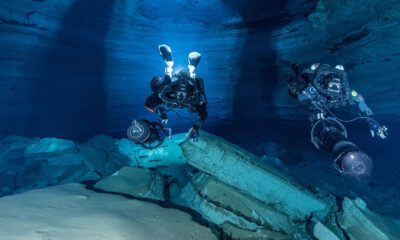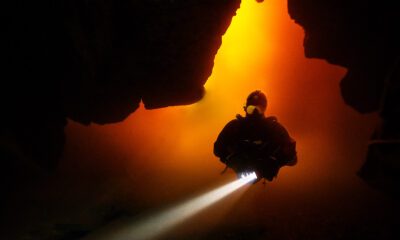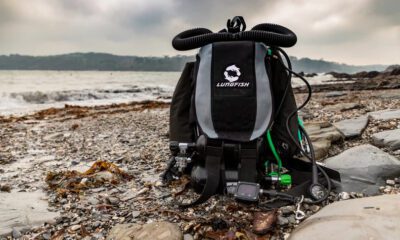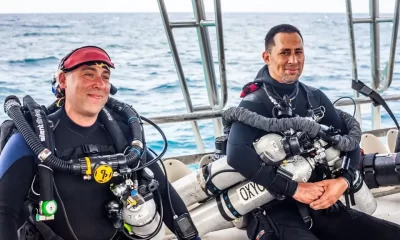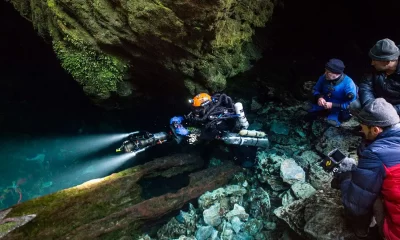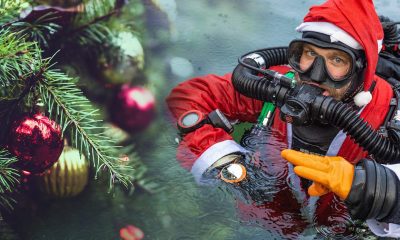Equipment
Grokking The FATHOM CCR: My Dive into the Nuts & Bolts with the Inventor
Launched in 2016, the FATHOM mechanical closed circuit rebreather (mCCR) has gained supporters among deep cave explorers and those distrustful of underwater electronics, who say they favor its simplicity, robustness and unique valve system that overcomes the disadvantages of traditional mCCRs. We asked tech and cave instructor Jon Kieren, who’s familiar with the unit, to share his experience and dive into the nuts and bolts with FATHOM inventor Charlie Roberson.
By Jon Kieren. Images by SJ Alice Bennett.
Full Disclosure: FATHOM Dive Systems is an InDEPTH advertiser.
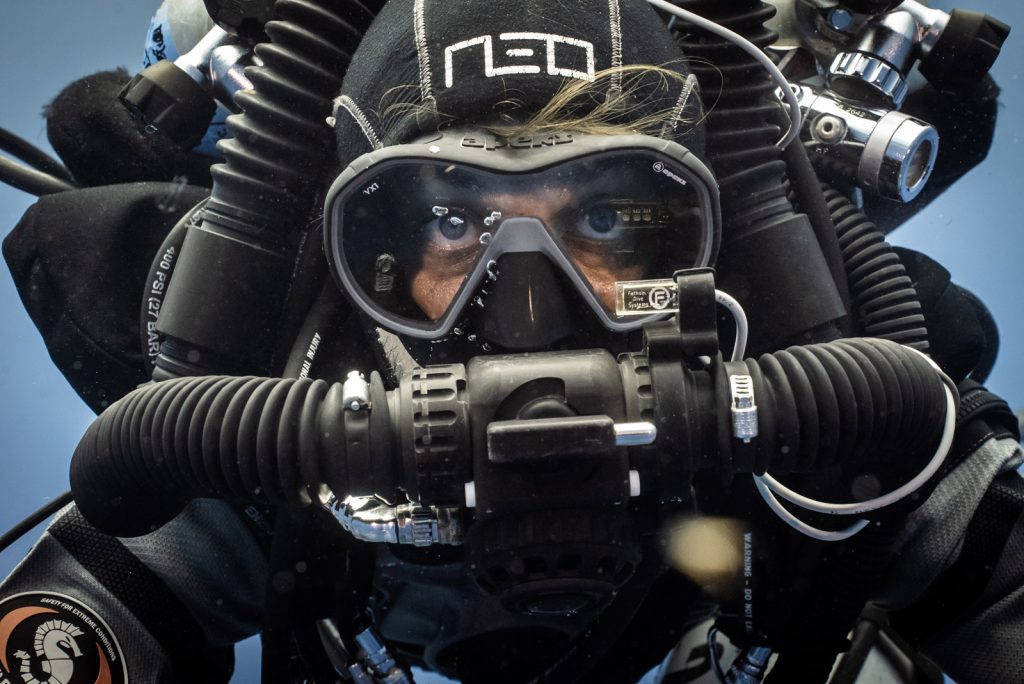
Also see accompanying story, “Not All mCCRs are Created Equal: The Case for the Needle Valve,” by Charles Roberson
As a professional technical and cave diving instructor, I’ve spent some time on rebreathers. I started diving rebreathers in 2012 due to the extraordinary cost and short supply of helium in the Virgin Islands, where I was living at the time. Over the years, I’ve trained on pretty much every unit on the market, and spent a fair bit of time on some of my favorites. I’ve bounced between electronic closed circuit rebreathers (eCCR), mechanical closed circuit rebreathers (mCCR), semi-closed rebreathers (SCR), backmount, sidemount, all the variations. I’ve spent the vast majority of the time on the loop of units coming out of the iQsub factory, starting with the Hammerhead, then evolving to the Defender, X-CCR, and even the FLEX 2 sidemount unit. I was always reluctant to switch away from those units as they have proven to be reliable, easy to dive and travel with, and well suited for the diving that I was doing, which was mainly deep long range cave dives and a bit of deep ocean diving.
But then came the FATHOM CCR, and I was immediately intrigued.

Another Rebreather?
Why the interest if I was already diving what I considered to be nearly perfect units? The simple answer is electronics. Silly, overcomplicated, and unnecessary electronics that are constantly adding features and failure points. Not to mention a pesky solenoid that always fires at the worst possible moment and throws off your buoyancy. Don’t get me wrong, I’m a gadget guy, but only if it’s necessary and improves performance without sacrificing reliability.
In my experience, the electronics we see implemented in CCRs over the past ten years have done little to improve performance and continue to add failure points. Complicated CAN bus systems, more batteries, more components, more connections all in the name of redundancy and automation. Most rebreather failures I’ve seen that have kept units out of the water (both my own as well as students and teammates) have been electronics related, and it was getting tiresome.
As a result, I had been looking at mechanical solutions for some time but was not satisfied with the options on the market. Poor loop designs, small scrubbers, poor work of breathing, flood intolerant, and depth limited fixed orifice designs, to name a few of my gripes. So to see a new unit with a very similar loop design that I had grown to love and trust, and a unique spin on the mCCR, I had to get a closer look.
Only The FATHOM Knows
Charlie Roberson, owner of FATHOM Dive Systems, was already a friend of mine, and a few of my buddies were already diving the unit, so it was easy to take a peek, and a few things stood out to me right away. First of all, the elegantly simple design. Much of the unit seemed similar to what I was used to, until I looked closer at the head. Super compact, fully potted (impossible for water to penetrate into the electronics through the head), and only three exposed connectors for the sensors. You can actually soak the entire head in fresh water to rinse it (after removing the sensors, of course). The handset is either hardwired or available with 4-pin AK connectors. The HUD is hardwired for maximum reliability. There are only two power sources: one battery for the HUD and one for the handset. Simple and streamlined, not much to break. I liked what I saw, so I booked a crossover with Kelvin Davidson, a Fathom instructor and owner of Third Dimension Diving, to give it a thorough try before placing an order.
Diving the unit was pretty much identical to what I was used to, except for the needle valve (See accompanying story), and man, what a difference. Super smooth injection, almost no input needed from the diver once it was dialed in, and on the trigger of a scooter…what a dream! We’ll describe more about the needle valve a bit later, but after one dive I knew I wouldn’t be going back to eCCR.
So let’s hear from Charlie about his inspiration for the unit and why he made the design choices he did.
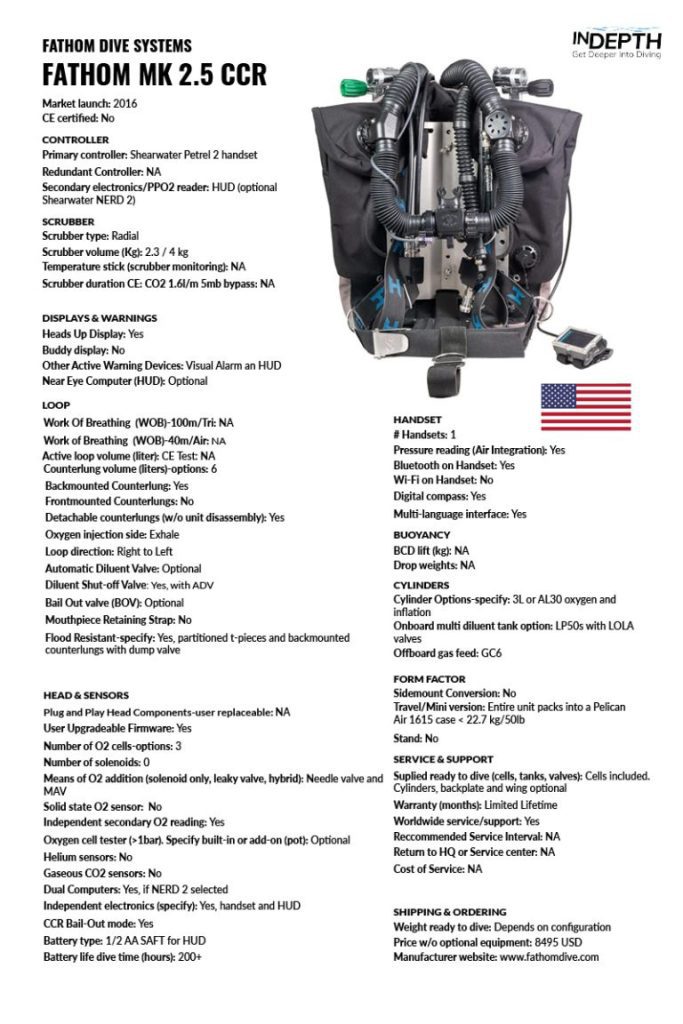
Jon: So, Charlie, you were a lawyer. Why the hell start building rebreathers in what most would say was already a pretty flooded market?
Charlie Roberson: Well, I still am a lawyer, but my real passion is diving, so I started FATHOM Dive Systems in 2013 and, after several years of design and testing, released the FATHOM CCR in 2016. I had recently moved to CCRs for my own diving, which was pushing the practical limits of open circuit, and I just wasn’t satisfied with any of the CCRs on the market. So I set out to build exactly what I needed, which was an extremely robust CCR with long duration and excellent work of breathing. The result is the FATHOM CCR.
We have a detailed article about the specifics of the needle valve in this issue of InDEPTH, so we won’t get into much detail on that. But tell us why you felt it was the best overall solution for the FATHOM.
The needle valve solves many of the shortcomings of a traditional fixed orifice mCCR. The oxygen IP doesn’t need to be set at or below your resting metabolic rate since that adjustment is handled on the fly by the needle valve. This means we can vary the flow to match our metabolic rate with different workloads, i.e., swimming vs deco. This also allows us to modify the first stage with a stronger spring and raise the IP to increase the depth limit. On the FATHOM CCR, we set the IP at 14 bar, which gives a practical depth limit of 400 fsw and it can be raised to 19 bar in the field for a 600 fsw depth limit. The needle valve is also much more tolerant of debris, which can and does clog fixed orifice units.
And what about the scrubber? Why radial, and why “inside to out” flow?
A radial scrubber is more efficient, which means longer duration for a given volume of sorb. Radial scrubbers also have a shorter bed length, which means better work of breathing. Unlike axial scrubbers, the bed length on radial scrubbers remains the same with increases in scrubber size. This means that large capacity radial scrubbers will always outperform large capacity axial scrubbers.

You only offer back mounted counterlungs on the FATHOM, what advantages do they offer over front/chest mounted lungs?
Arguably, large front-mounted counterlungs have the best work of breathing. However, the breathing difference between them and well-designed back-mounted counterlungs is minimal and doesn’t justify the significant disadvantages, which include: an increased profile, increased drag, and difficulty handling stage/deco bottles.
Another unique aspect of the FATHOM is the canister material. Most manufacturers use Delrin or Aluminum. What is Black Amalgon, and what makes it a better fit for the FATHOM?
Black Amalgon is a fiber-reinforced thermoset epoxy matrix. It is a lightweight, high-strength, corrosion-resistant composite alternative to carbon steel, honed and chromed steel, stainless steel and aluminum or brass cylinders. Black Amalgon features an easy to clean ultra-smooth inner surface which is an ideal o-ring sealing surface. Black Amalgam is 400 times less thermally conductive than aluminum so the scrubber stays warm, which greatly improves scrubber efficiency.
You’ve decided to develop your own HUD instead of using an off-the-shelf option like Shearwater’s. What led you to that decision?
We used the Shearwater HUD for several years but ultimately wanted to add some features that improve safety and useability. The new HUD takes the simplicity and effectiveness of the modified Smithers code on the Shearwater HUD and adds a few improvements. First, it has automatic brightness. You can reverse the orientation for left- or right-hand use. Finally, there is a user definable visual alarm feature that, when enabled, will warn divers of dangerously high or low PO2.
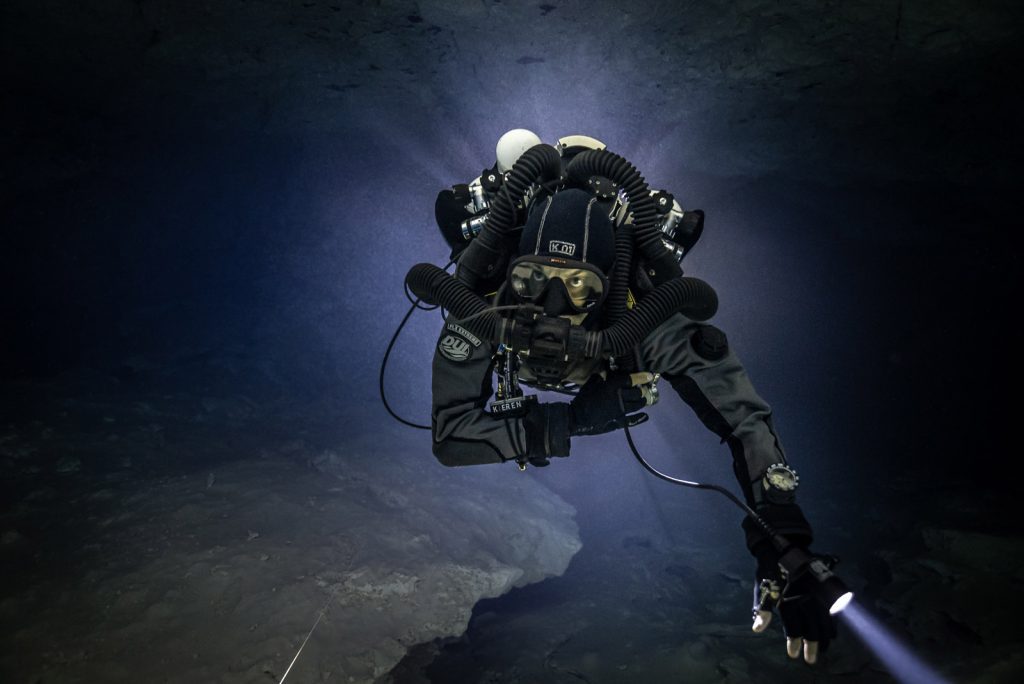
Bailout valve (BOV) vs Dive Surface Valve (DSV)? You offer both. Which is most popular, and what’s your personal opinion?
The Shrimp DSV is standard, but the BOV is by far the more popular choice on the FATHOM CCR. I dive with a BOV and believe that it’s an important part of the overall configuration. On the FATHOM CCR, the BOV is plumbed into the diluent MAV bypass, so whatever gas is plugged into the diluent, MAV QC6 feeds both the unit and the BOV. This keeps it simple and is particularly useful when diving hypoxic bottom gases, since you can plug in a breathable gas on descent or ascent to ensure that you always have a breathable bailout. The BOV also makes donation of the long hose—which we stow under the loop and clipped to the right D-ring—simpler and easier to perform.
Tell the readers a bit about the configuration options, traditional with onboard 3L cylinders vs onboard bailout.
We offer and teach two main configurations, which are a bit different from traditional CCR setups. Both utilize combined diluent/bailout carried in appropriate volumes. First, is the cave rig, which is based around side-mounted diluent/bailout and has onboard oxygen and inflation gas in 3L steel or AL30 cylinders. One major difference is that we orient the onboard cylinders valves up, which greatly improves trim and simplifies hose routing. The other configuration is the tech rig, which uses onboard LP50s or AL40s and a flexible manifold. Three liter oxygen and inflation gas cylinders are mounted behind the LP50s. The tech rig works extremely well for boat diving and limited cave penetrations.
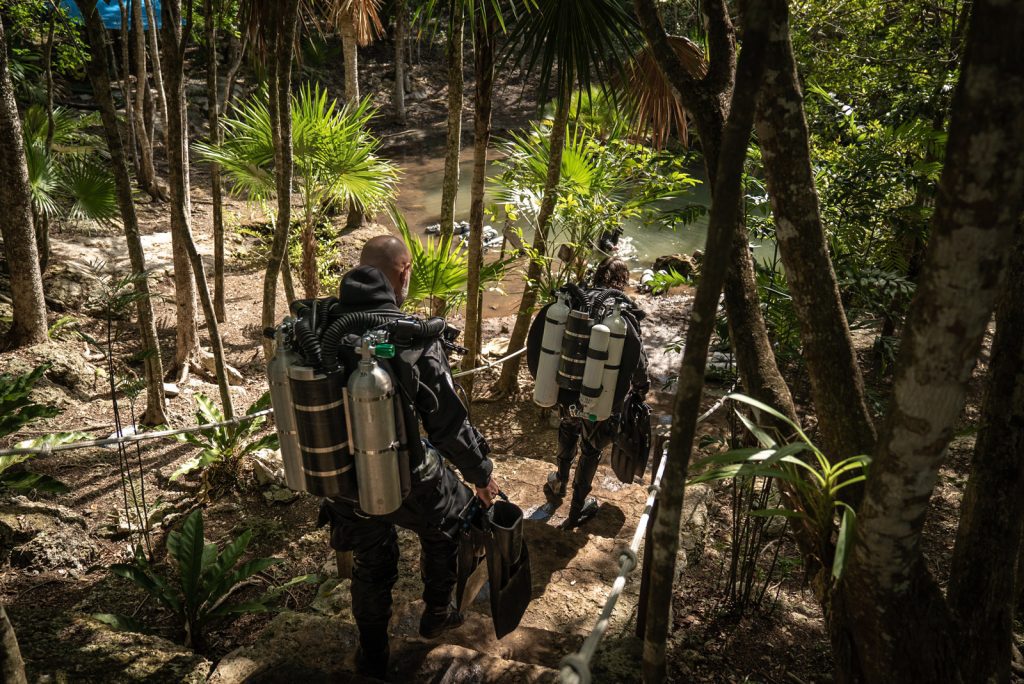
Is there anything else you’d think readers would find interesting about the FATHOM?
The FATHOM CCR has proven to be extremely capable for long range and deep cave exploration. The FATHOM CCR was used in the 8,208 m/26,930 ft world record cave penetration at Cathedral Canyon and has successfully explored Weeki Wachee cave system to depths over 400 ffw.
And one last question that I’m sure loads of people are dying to know…any chance of a sidemount version?
Yes, in fact we plan to release a sidemount unit called the Gemini CCR this fall.
This month we’re launching a survey panel on dive computing. Please help us by sharing your thoughts & practice at: Dive Computers-Exploratory Survey.
Dive Deeper:
Diveimmersion.org: The Brain Behind FATHOM Systems
InDEPTH: Divesoft’s Jakub Šimánek argues that human divers are the weak link in CCR diving not electronics: Building A Fault Tolerant Rebreather: Our Path to Simplicity
InDEPTH: Sump Potion #9 by Jon Kieren
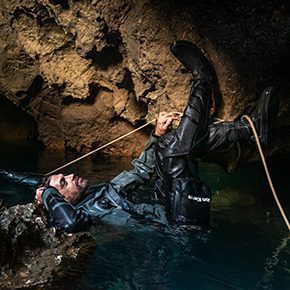
Jon Kieren is a cave, technical, and CCR instructor/instructor trainer who has dedicated his career over the past 13 years to improving dive training. As an active TDI/IANTD/NSS-CDS and GUE Instructor, and former training director and training advisory panel member for TDI, he has vast experience working with divers and instructors at all levels, but his main professional focus resides in the caves. In his own personal diving, Jon’s true passions are deep extended range cave dives (the more deco the better), as well as working with photographers to bring back images of his favorite places to share with the world.




















